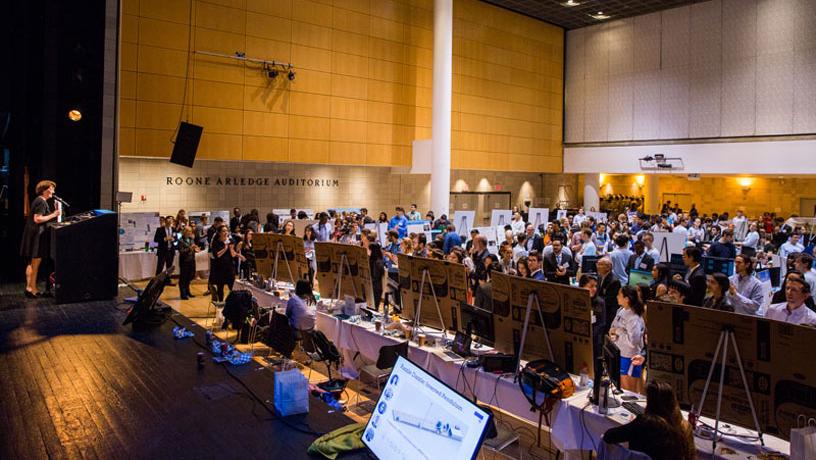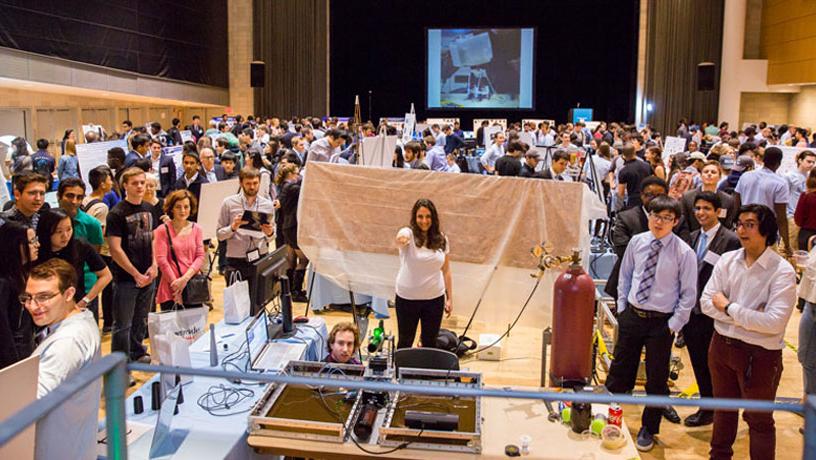Senior Design Expo Showcases Our Outstanding Class of 2017
From a beach cleaning robot to affordable diagnostic tools and better-fitting prosthetics, Columbia Engineering’s fourth annual Senior Design Expo showcased the ingenuity and innovation of the Class of 2017. Hundreds of students, faculty, colleagues, and friends gathered at Lerner Hall on May 3 for the event, which showcased senior capstone projects aimed at projects aimed at impacting humanity, ranging from patent-pending consumer products to cutting-edge research to proposals for practical improvements to New York City infrastructure.
Watch students show off their projects at this year's Senior Design Expo. Video by Jane Nisselson.
Among the many groups tackling human needs were biomedical engineers working on diagnosing and treating maladies quickly and at low cost. Amnitect (Olivya Caballero, Rosa Kim, Namji Park, and visiting junior Shaw Yang) is an insertable device that can help women tell if they have elevated levels of amniotic fluid during pregnancy, helping to detect premature ruptures of the amniotic membrane, while Lumenda (Lizzette Delgadillo, Bryan Louie, Priya Medberry, and Sid Perkins) is a point-of-care device for diagnosing neonatal bacterial meningitis in low-resource settings. Perkins will travel to Uganda in June to pass on the intellectual property to another organization, he explained, as his teammates will be busy with research and/or medical school and he will be working in Paris as a Fulbright Fellow.
Women’s health in Uganda inspired AdneXXa (Tess Cernonsky, Erika McManus, Nina Moiseiwitsch, and Lara Warner), a low-cost female condom that can be boiled for reuse, while Haiku Prosthetics (Amanda Jimenéz, Roberta Lock, Chiang Lu, Georgiana Yang, and William Yu) is waiting on a patent for the adaptable, universal prosthetic socket they designed to help children growing up with artificial limbs. Smartphones enable LUNA (Shujian Deng, Kristopher Harris, Nicholas Primiano, Payal Rana, and Zane Zemborain), a laser ultrasound-guided biopsy needle aid that uses a smartphone app for better insertion, and Sirena (Josh Hughes, Rachit Mohan, Derek Netto, Alexandra Nuzhdin, and Zaheen Sarker), a trimodal assistive system to help EMTs document treatments while keeping their hands free for patient care.
Electrical engineers John Kotey, Chris Kunkel, and Julian Vigil combined a sensing device, machine learning, and an app to create TearsTalk, which analyzes babies’ cries and is expandable to interpret other sounds. The project made the semifinals of this year’s Columbia Venture Competition.
“A baby’s cry contains tons of information, from hunger or discomfort to larger health concerns,” Kotey said. “Our device accounts for ambient noise and is expandable so long as we have an audio signal.”

lorem ipsum dolor sid amet.

lorem ipsum dolor sid amet.

lorem ipsum dolor sid amet.
Others created artistic robots, like the RoBach (Will Cao, Eli Epperson, Cynthia Kallif, Amritha Musipatla, Nick Scarfo, and Johanan Sowah), which combines a Mozart-trained artificial intelligence with an analog synthesizer to compose and improvise music, and Toulouse (Amelia Dunn, Evan Hertafeld, Yadir Lakehal, and Aramael Pena-Alcantara), which paints portraits. Mobile robots ranged from the spherical Robot that Rolls (Grace Liu, Trevonna Meikle, Peter Luning Prak, and Yuchuan Zhang) to Honu, a turtle-like autonomous beach cleaning robot (Bradley Beeksma, Daniel Gonzalez, Jamie Hall, and Alyssa Nicole Posecion).
Also presenting were civil engineers including Kevin Chiu, Colton Doering, Stephen Ho, Rashed Al Qudah, Anel Redzematovic, and Hua Zheng, who designed a proposed extension of New York City’s AirTrain to Astoria, Queens for faster trips to the city’s airports. Chemical engineers John Bender, Sophie Jo, and Zoe Zegers designed a potential plant for producing methanol fuels, while earth and environmental engineers Chris Ahn, Fred Enea, Anna Libey, Xiaocong Susan Liu, Colette McCullagh, and Maria Torres worked with the New York Metropolitan Transportation Authority (MTA) on ideas for cooling the city’s scorching subway platforms during the summer.
Mechanical engineers Jake Abitbol, Kevin Baquero, Lane Baze, and Benjamin Machtinger designed and made the windproof ONEbrella, which uses a unique double structure to function while still allowing wind through.
“We thought we were done after today,” said Abitbol. “But after all the questions and interest we’ve gotten, we might have to reconsider.”
